Check out our range of stock.
Didn't find what you like?
Send us a message
Found something out of stock?
Send us a message
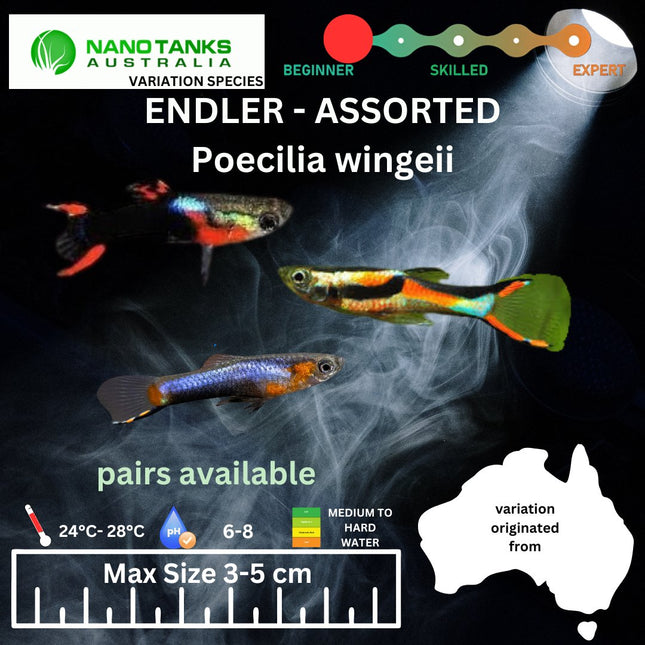
Our Assorted Endlers are locally bred, they are all mixed genetics and offer a range of colours. When buying endlers we recommend either going all males or a ratio of 1 male to 2 females or more. this is to ensure the females are not getting too stressed out by the males who will constantly chase them wanting to breed. Temperature: 24 – 28°C pH: 6.5 – 7.8 Hardness: 8-12 dGH Lifespan: 2+ years Max Size: 3-5cm Diet: Omnivore
$5.00 - $8.00
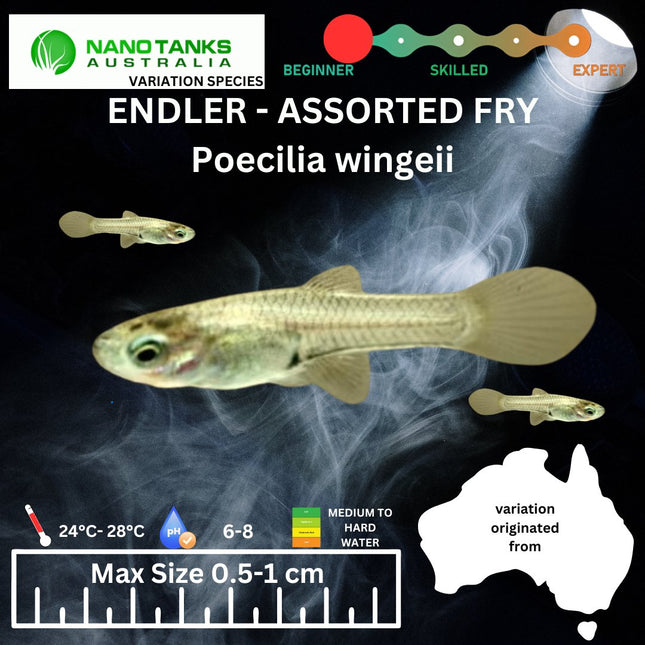
Our fish breed all the time and we will usually get fry every few days. The listing here are between 2-6 weeks old. The fry will come from our mixed endler tanks and it will be random. When buying endlers we recommend either going all males or a ratio of 1 male to 2 females or more. this is to ensure the females are not getting too stressed out by the males who will constantly chase them wanting to breed. Temperature: 24 – 28°C pH: 6.5 – 7.8 Hardness: 8-12 dGH Lifespan: 2+ years Max Size: 3-5cm Diet: Omnivore
$0.99
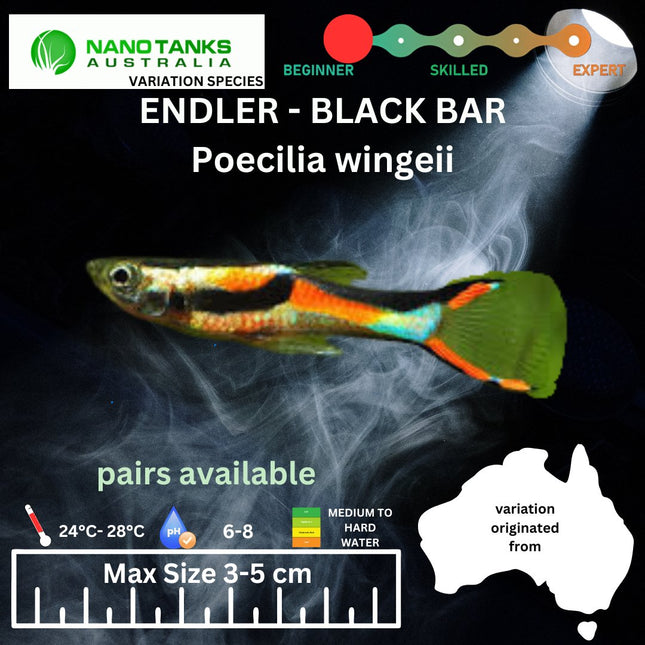
When buying endlers we recommend either going all males or a ratio of 1 male to 2 females or more. this is to ensure the females are not getting too stressed out by the males who will constantly chase them wanting to breed. Temperature: 24 – 28°C pH: 6.5 – 7.8 Hardness: 8-12 dGH Lifespan: 2+ years Max Size: 3-5cm Diet: Omnivore
$5.00 - $8.00
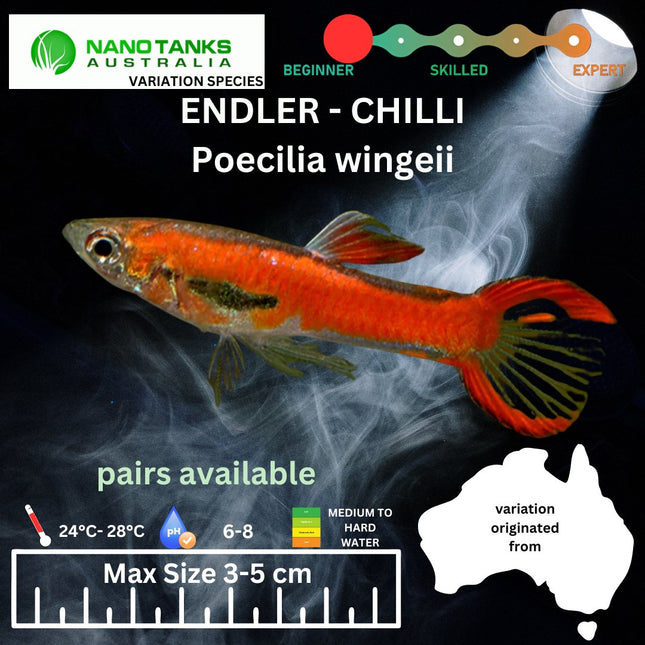
When buying endlers we recommend either going all males or a ratio of 1 male to 2 females or more. this is to ensure the females are not getting too stressed out by the males who will constantly chase them wanting to breed. Temperature: 24 – 28°C pH: 6.5 – 7.8 Hardness: 8-12 dGH Lifespan: 2+ years Max Size: 3-5cm Diet: Omnivore
$10.00 - $15.00

When buying endlers we recommend either going all males or a ratio of 1 male to 2 females or more. this is to ensure the females are not getting too stressed out by the males who will constantly chase them wanting to breed. Temperature: 24 – 28°C pH: 6.5 – 7.8 Hardness: 8-12 dGH Lifespan: 2+ years Max Size: 3-5cm Diet: Omnivore
$10.00 - $15.00
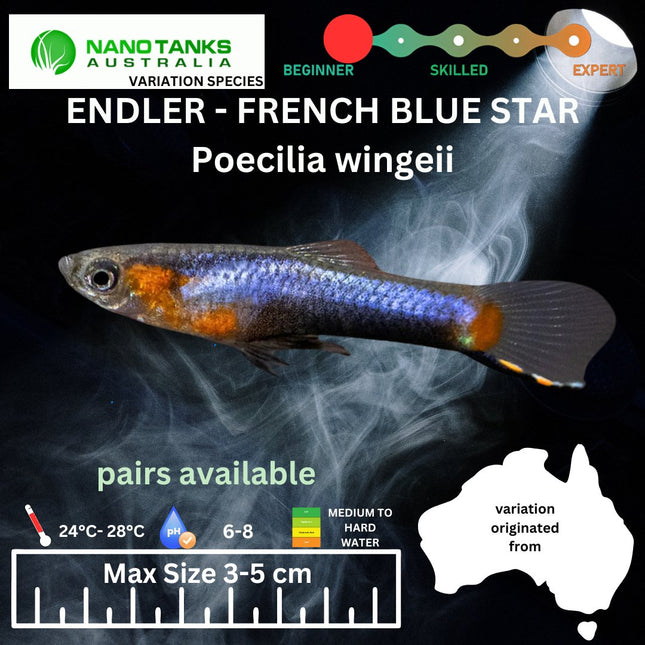
When buying endlers we recommend either going all males or a ratio of 1 male to 2 females or more. this is to ensure the females are not getting too stressed out by the males who will constantly chase them wanting to breed. Temperature: 24 – 28°C pH: 6.5 – 7.8 Hardness: 8-12 dGH Lifespan: 2+ years Max Size: 3-5cm Diet: Omnivore
$8.00 - $13.00
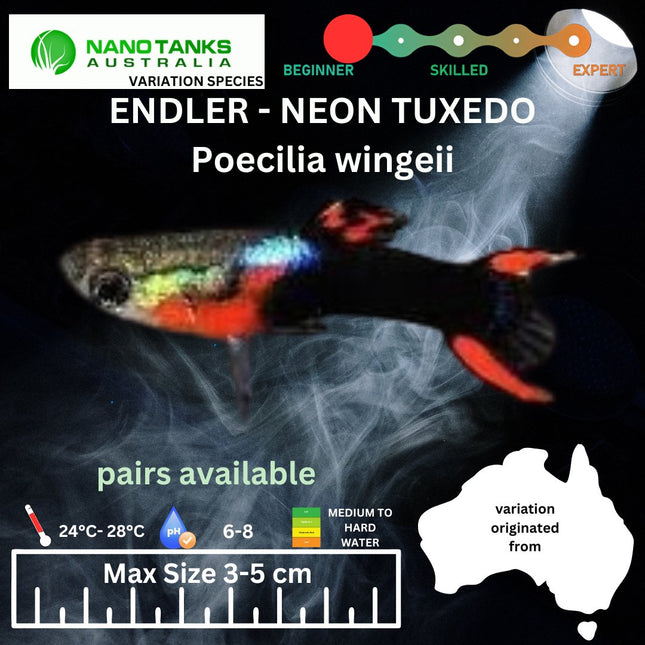
When buying endlers we recommend either going all males or a ratio of 1 male to 2 females or more. this is to ensure the females are not getting too stressed out by the males who will constantly chase them wanting to breed. Temperature: 24 – 28°C pH: 6.5 – 7.8 Hardness: 8-12 dGH Lifespan: 2+ years Max Size: 3-5cm Diet: Omnivore
$10.00 - $15.00

When buying endlers we recommend either going all males or a ratio of 1 male to 2 females or more. this is to ensure the females are not getting too stressed out by the males who will constantly chase them wanting to breed. Temperature: 24 – 28°C pH: 6.5 – 7.8 Hardness: 8-12 dGH Lifespan: 2+ years Max Size: 3-5cm Diet: Omnivore
$6.00 - $10.00

Mystery box live fish plants foods accessories is a subscription box that brings a selection of live fish, plants, foods, and accessories to your door each month. The selection varies each month, but you can expect to receive a variety of items such as live fish, aquatic plants, food items, and accessories that are perfect for setting up and maintaining a beautiful aquarium. You can also expect to receive detailed care instructions to ensure the health and happiness of your new aquatic family. All of the items are carefully selected to be safe and of the highest quality, guaranteed to bring a bit of mystery and excitement to your aquarium.
$250.00 $150.00

Feeding portals for shrimps and small fish are specially designed aquarium accessories that provide a safe and convenient way to feed small, aquarium inhabitants. They feature a small, netted opening that allows food to be safely dispensed into the aquarium without the risk of fish being scared away or shrimps, snails, and other small creatures being injured by larger fish. They are made out of durable, easy-to-clean materials, and come in a variety of shapes and sizes to accommodate the needs of any aquarium. They are the perfect way to give your small fish and shrimp the nutrition they need without disrupting their environment.
$9.00

Firetail Gudgeon Scientific name: Hypseliotris galii Is a carnivorous fish, well suited for garden ponds and aquariums. Exhibit territorial behaviour with each other, but generally behave peacefully with other fish, however they will prey on fish small enough to swallow. Tolerates temperature from 10°c – 25°c and pH range between 6.5 – 8. Can grow up to 7cm. Will breed in your pond. Will help control mosquitoes by feeding on the larvae.
$6.00

THIS IS FOR IN HOUSE ORDERS ONLY. PLEASE DO NOT USE THIS PRODUCT
$0.00
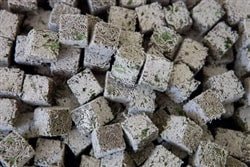
Australian Black Worms (aka Tubifex worms) are a natural food that nature provides and are readily taken by aquatic creatures. They make a great high-protein treat for fish, especially fish looking for food with a lot of protein. Our worms are sold in both loose form and in cubes. Clean Food Because the worms are killed and boiled before they are cleaned, they go though the same cleaning and purging process as if they were going to be fed live. They are then frozen in 2.5 kg blocks and loaded into the Cuddens freeze drier. A vacuum pump creates an airless environment by removing all the air from a chamber, then heats it from minus 20C to 50c. Water boiled at 0 degrees Celsius in a vacuum. As frozen worms started to thaw, all moisture turned into vapour that was then refrozen on coils inside the chamber. The process of freeze drying is a little more complicated then that, but the basis for how it works is this. The important thing about the freeze-drying process is that it removes all moisture from worms without altering their nutritional facts. The whole process from growing, cleaning and processing to produce your final product begins at a facility in order to ensure you get top quality food grade products each time! Disease-free Australia has very few if any diseases that are transmitted from water to fish, and the area where these black worms live is away from farming and industrial areas. The worm's water used to come straight out of the same supply we drink our drinking water out of up until recently. Difference between live worms and freeze-dried worms The only difference between the two is that live worms contain water. Different ways to feed cubes. To get fish to show interest in your freeze-dried worms, put one cube inside the tank halfway down. The fish will then be more inclined to eat it. When they do, try placing another closer to the surface so your pet can grab them easier! Australian Freeze Dried Black Worms are one of the most nutritious foods for Discus, Corydoras and other fish types as well. This has bio pigment laced through it that is designed for bringing out the red and yellow of the fish. This is a natural colour enhancer made primarily from Carrots. They consist of 45% crude protein and is 8x more condensed then Live Black Worms
$12.00
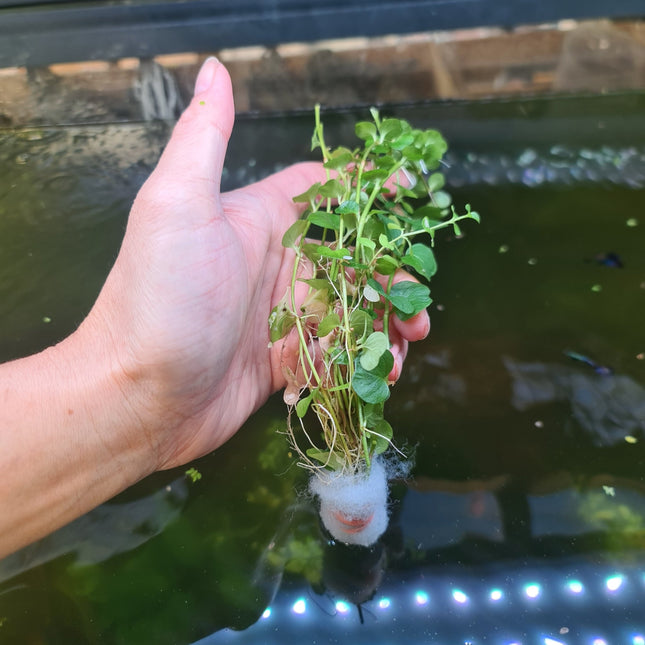
Brazilian Pennywort is a great plant for the home aquarium. It can be kept as either rooted or floating, and it will grow up toward light with its leaves shaded underneath in order to provide cover from intruders looking for safe resting spots. Brazilian Pennywort leaves offer a beautiful green colour to your tank. They're different from some other plants, like Water Sprite or Anacharis that may be more typical in an aquarium setting but are still worth keeping if you want something with interesting variety! Brazilian pennywort (Hydrocallis tr subcontracta) is quite unusual among plant life for exactly this reason: its leaf shape sets it apart visually as well as anatomically--you can tell right away just by looking at them whether they come from Brazilians or not; there's nothing else remotely similar out there anywhere nearby either inside our own country borders Aquarium pH: 6.0 – 7.8 Water Temperature: 22 – 30°C Tank Size: Any, but the plant can grow fast and take over quickly Lighting: Wide range, community tank lighting should work fine
$10.00

Characteristics Family Cyprinidae Origin Red River Basin China, Taiwan, Vietnam Social Peaceful schooling fish Tank Level Bottom, Mid-dweller Minimum Tank Size 20 gallon Diet Omnivore Breeding Egg scatterer Care Easy pH 6.0 to 8.0 Hardness Up to 10 dGH Temperature 64 to75 F (18 to 24 C) Colors and Markings The gold barb has a steeply-sloped back and short barbels positioned at the corners of the mouth. A number of dark vertical bars or blotches are visible along the flanks of the fish. Well-conditioned specimens may also have red coloration on the fins. The naturally occurring color of this barb is green, but the green P. semifasciolatus is rarely seen in the aquarium trade due to the overwhelming popularity of the gold form. Virtually all specimens currently sold are captive-bred, and a few other color variations have subsequently arisen, including an albino variant as well as a tricolor variation. This gold form was selectively bred by Thomas Schubert in the 1960s and was at one time thought to be a distinct species, referred to as Barbus schuberti or P. semifasciolatus var. schuberti. It is now known to be the same species as the wild form. Tankmates Gold barbs are schooling fish and should be kept in groups of at least a half-dozen or more. The peaceful nature of this species makes them an excellent choice for community aquariums of other similarly-sized peaceful fish including tetras, danios, and other small barbs. Gold Barb Habitat and Care Gold barbs are quite hardy and undemanding of water conditions or habitat essentials. They originate in free-flowing streams and rivers, so use a powerhead to provide a decent current. They should be provided with a good-sized open space for swimming, along with plants, driftwood, or other decors for use as hiding spots. Use a fine-grade substrate, preferably of a darker color to showcase the colors of the fish. Gold Barb Diet and Feeding In their natural habitat, this species lives on a diet of insects and their larva, as well as worms, vegetation, and even detritus. It's a prime example of an omnivore, eating just about anything available. To maintain optimal health, a varied diet is advisable. Flake, pellet, freeze-dried and frozen foods will all be readily accepted. When possible, include live foods such as insects, brine shrimp, and worms of all types. Fresh vegetables are an excellent added supplement. Gender Differences Females are overall much duller in coloration and larger than the male, as well as rounder in the belly. The belly of mature males who are ready to spawn will turn red to red-orange in color. Breeding the Gold Barb Gold barbs are relatively easy to breed, but as with breeding most fish species, a separate breeding tank is recommended. The tank should be well-planted with fine-leafed plants such as java moss. Spawning mops can also be used. A mesh cover could be placed over the bottom of the tank to allow the eggs to fall through. Regardless of which medium is used for spawning, make sure there are plenty of hiding spots for the female, as the male can be quite aggressive during the spawning process. Lighting should be dim, and the water should be soft at about 8 dGH, with a pH between 6 and 7. Use a sponge filter with a very gentle flow. Spawning can be attempted with pairs or by using the group method. When spawning in a group, use a half-dozen of each sex. If spawning in pairs, maintain separate tanks of males and females. Select the plumpest female and most brightly colored male, and introduce them to the spawning tank late in the day. Prior to spawning with either method, condition the breeders for several days with live foods. Typically, spawning occurs in the early morning around dawn. Males will begin to circle the female, nudging her in order to position her near the area he has selected for spawning. The female will release up to 300 eggs, which will then be fertilized by the male. Adults will readily eat the eggs, so as soon as the eggs have been fertilized, the adults should be removed from the tank. The pale yellow eggs will hatch in about 48 hours, and the fry (baby fish) will be free swimming in a few days. Feed the fry on infusoria, fine fry food, and freshly hatched brine shrimp. Both the eggs and fry are rather sensitive to light, so keep the tank as dark as possible until the fry are several weeks old.
$5.00

Green Syngonium, also known as Syngonium podophyllum or Arrowhead Vine, is a popular houseplant and aquatic plant in the family Araceae. It is native to tropical rainforests in Central and South America, but is widely cultivated as an indoor or outdoor plant in many parts of the world. In aquariums, Green Syngonium is often used as a low-maintenance foreground or midground plant. It can grow both submerged or emersed, and is usually planted in the substrate or attached to hardscape such as rocks or driftwood. The plant has arrowhead-shaped leaves that are typically green with white or silver veins. When grown emersed, the plant can produce small white flowers. Green Syngonium is an easy-to-care-for plant that tolerates a wide range of lighting and water conditions. It prefers bright, indirect light and water temperatures between 20-28°C. It can also be grown in a wide range of water hardness and pH, but does best in slightly acidic to neutral conditions. The plant does not require CO2 injection, but can benefit from regular fertilization to promote healthy growth.
$20.00

Add a splash of colour to your aquarium with the Assorted Hi Fin Platy. These colourful tropical fish are a great addition to any freshwater tank, and their vibrant fins add beautiful detail and intrigue. Their peaceful nature makes them an ideal choice for any community tank.
$8.00
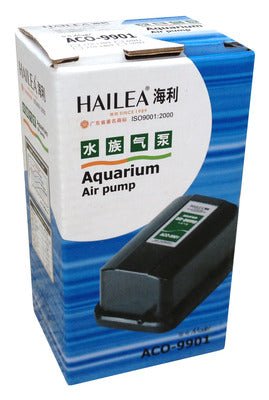
Description: Single Outlet 1.3 L/min Manufacturer: Hailea Features Small compact single outlet air pump for aquariums Modern compact design. Simple setup and operation, quick start. All models come with rubber feet, to avoid vibration. Reliable. Power usage: 2 watts Pressure: >0.01Mpa Size: 104x61x51mm Please remember to always use a check valve or non return valve.
$12.00
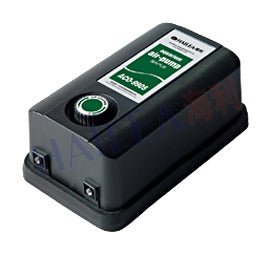
Description: Double Outlet 6.5 L/min with Variable air flow control Manufacturer: Hailea Features Small compact double outlet air pump for aquariums Modern compact design Simple setup and operation, quick start All models come with rubber feet to avoid vibration Reliable Power usage: 6 watts Pressure: >0.015Mpa Size: 158x94x68mm Please remember to always use a check valve or non return valve.
$35.00
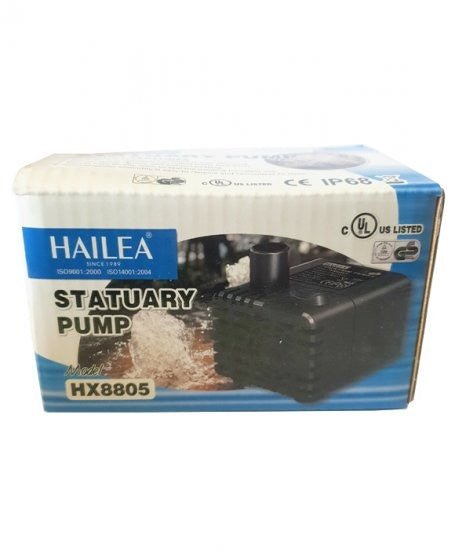
PRODUCT FEATUREScompact, low power consumption & high efficiencythw water flow regulator can adjust water flow freelyoperate stably, silently and without heatingadopts high quality resin to seal the winding for safety userotor/impeller assembly is easy to remove and convient to cleanPower - 6 wattFlow - 450 l/hrMax Jet M - 0.75Weight - 0.22kgExternal size - 54 x 47 x 52mm
$24.00
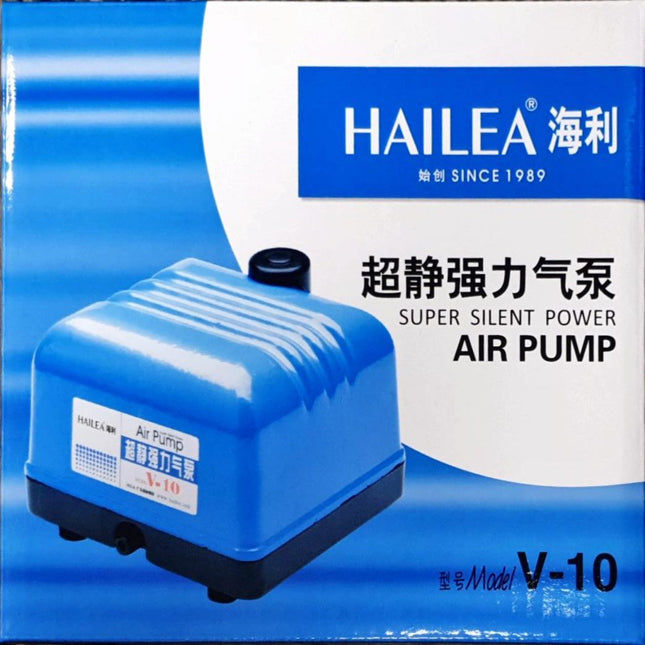
Voltage 110-115V 220-240V Frequency 50/60Hz Power 10W Output 10L/min Pressure >0.02Mpa Weight 1.3kg Package Size 179x158x164cm
$120.00
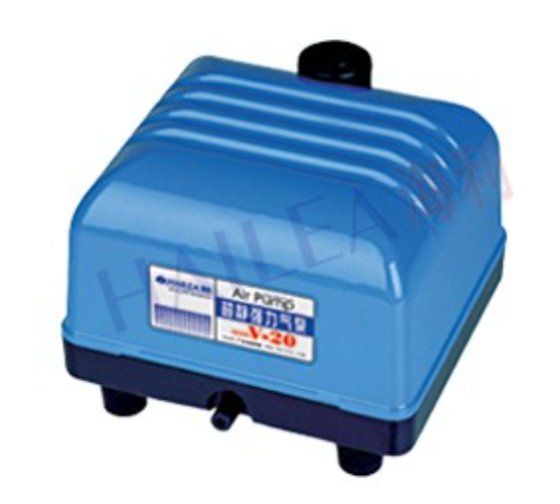
V-20 Air Hailea Pump The features of V series super silent power air pump:Adopts high quality aluminum alloy to make its case. It adopts double damping system and noise-absorbing system It is highly efficient ,energy saving,low in noise and safe.Double air chamber structure to produce large quantity of air and strong air pressure.It can work at readily and continuously. Power: 15W Output: 20L/min Voltage: 240v Weight: 2.5kg Pressure: >0.02Mpa Size: 230x185x180mm
$160.00

Bio Bricks 500g - Powerful Biological Filtration Boost "Your aquarium's invisible cleanup crew, supercharged!" What makes our Bio Bricks special?✔ Porous ceramic design - Massive surface area (500+ sq ft per 500g) for bacterial colonization✔ Instant cycle jumpstart - Cuts new tank cycling time by up to 50%✔ Continuous biofiltration - Supports 100L of water volume per brick How it works: Place in filter or tank Beneficial bacteria naturally colonize within 24-48 hours Maintains stable populations for years Proven benefits: Dramatically reduces ammonia/nitrite spikes Handles heavy bioloads from:• Crowded tanks• Large fish• Messy eaters Works in both freshwater and saltwater 500g bag treats:• 200L aquarium as main filtration• 400L as supplemental media The smarter way to biological filtration!
$18.00
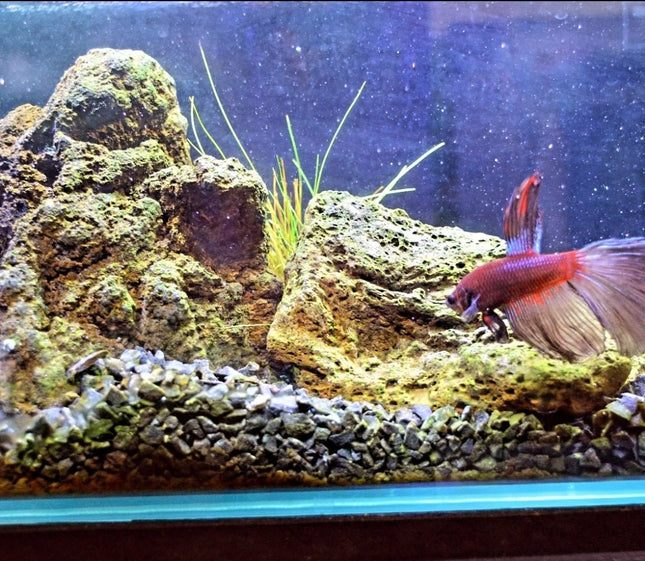
Black Lava is of volcanic origin, featuring a porous texture, making it very lightweight and versatile. Due to its comparably low weight, it is possible to create large structures with it. For example it is possible to design a “Green Reef”. Green Reefs are tall scapes covered in various epiphytes like ferns of the genus Microsorum or Bolbitis, Pogostemon helferi or different kinds of moss. Their roots will find a good foothold due to the porouse sctructure of the stone. Individual stones can still be moved or exchanged later on, making the layout modular. Also a classical Iwagumi can be made from Black Lava since the very dark colours make for a good contrast to the grey color of the more commonly used kinds of stone. As an advantage Black Lava does not increase the hardness of the tank water. Lava rock is often used in conjunction with roots. The individual stones can be covered with moss to form forest-inspired scapes. Do you know that Black Lava is also used in different settings and not for aquarium uses as well? We have had people using this for Fijian Ground Cooking to people using it as a filtration. Why does ot look like concrete? High quality black lava does look like concrete at times. At there unwashed state they do have a greyish tinge that looks like concrete. Concrete however turns to dust and pure concrete is very brittle. A lot of our customers may initially get disappointed as our pieces do come unwashed or they are dissatisfied with that one piece. We always advise our customers is if the pieces looks too big or they need to break it down, a chisel and a hammer will break it down nicely. Of course if you need our assistance then simply send a message and we can assist you with your enquiry. Shipping We can send up to 5kg. If you need more then 5kg, this will be a bulk order and you will be quoted separately. PLEASE NOTE THAT WE WILL DO OUR BEST TO PICK THE PIECES FOR YOU. PLEASE BE SPECIFIC IN YOUR REQUEST ON THE NOTES. All pieces are around 1kg and around 8-15cm
$10.00 - $65.00
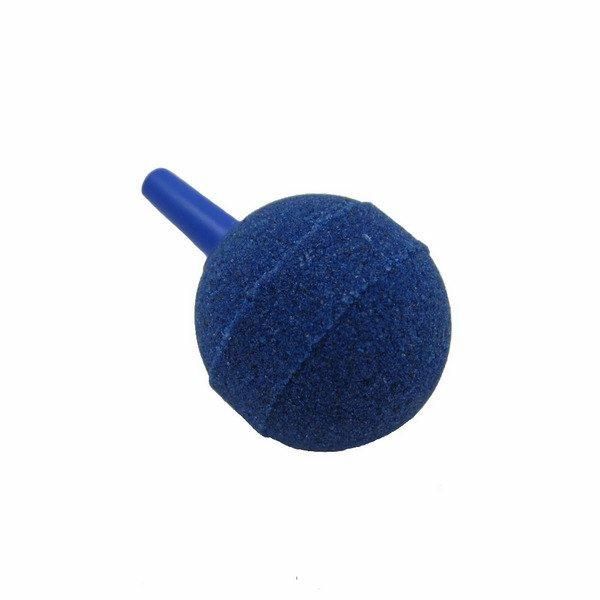
Hikari Airstone Round Blue 22mm is an air stone for aquariums and terrariums. This air stone is made from a high-quality ceramic material that is durable and produces a fine bubble stream. The round shape and bright blue color adds an aesthetic touch to any aquarium or terrarium. The 22mm size is ideal for medium-sized tanks and the air stone can be used with an air pump to provide oxygen to the tank and create a calming atmosphere. The Hikari Airstone Round Blue 22mm is easy to install and provides an efficient means of oxygenation for your aquatic environment.
$1.00
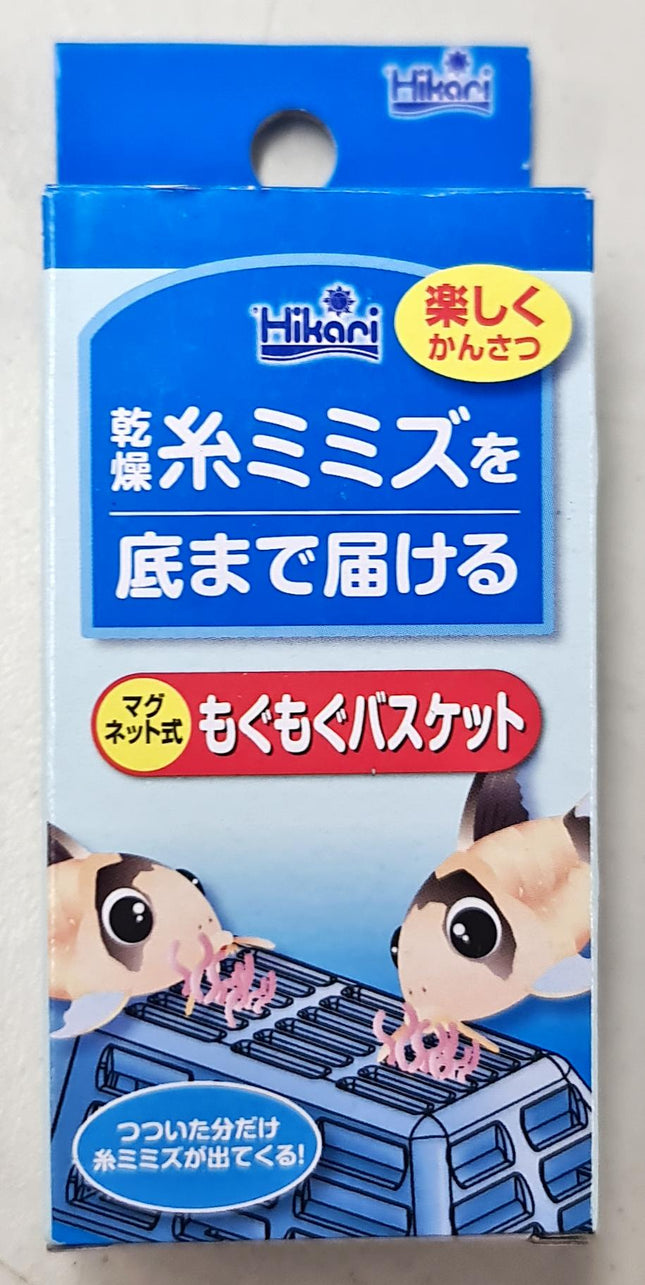
If you are looking for a convenient way to feed your aquarium fish, the Hikari Magnetic Fish Feeder may be just what you need. This innovative product is designed to make feeding time easier and more efficient for both you and your fish. In this article, we will explore the features and benefits of the Hikari Magnetic Fish Feeder and explain why it is a must-have for any serious fish keeper. One of the key benefits of the Hikari Magnetic Fish Feeder is its convenience. The feeder attaches to the outside of your aquarium using a powerful magnet, so there is no need to worry about suction cups or other attachments that can be difficult to use. The magnetic attachment makes it easy to move the feeder around the tank, allowing you to feed your fish from different angles and locations. Another advantage of the Hikari Magnetic Fish Feeder is its versatility. The feeder is designed to dispense a wide variety of fish foods, including flakes, pellets, and granules. It is also adjustable, allowing you to control the amount of food that is dispensed at each feeding. This is especially useful if you have a mix of fish in your tank that require different amounts of food. In addition to its convenience and versatility, the Hikari Magnetic Fish Feeder is also highly reliable. The feeder is made from high-quality materials and is built to last. It is also easy to clean and maintain, which is important for keeping your aquarium healthy and free of harmful bacteria. One of the best things about the Hikari Magnetic Fish Feeder is that it is suitable for both freshwater and saltwater aquariums. This means that no matter what type of fish you have, you can use this feeder to make feeding time easier and more efficient. At Nano Tanks Australia Aquarium Shop, we highly recommend the Hikari Magnetic Fish Feeder to all our customers. We have found that it is a reliable and effective way to feed your fish, and it is also very affordable. If you have any questions about this product or any other aquarium supplies, our team of experts is available to help you. Whether you prefer to shop online or in-store, we are here to provide you with the expert advice and support you need to keep your fish healthy and happy.
$29.00
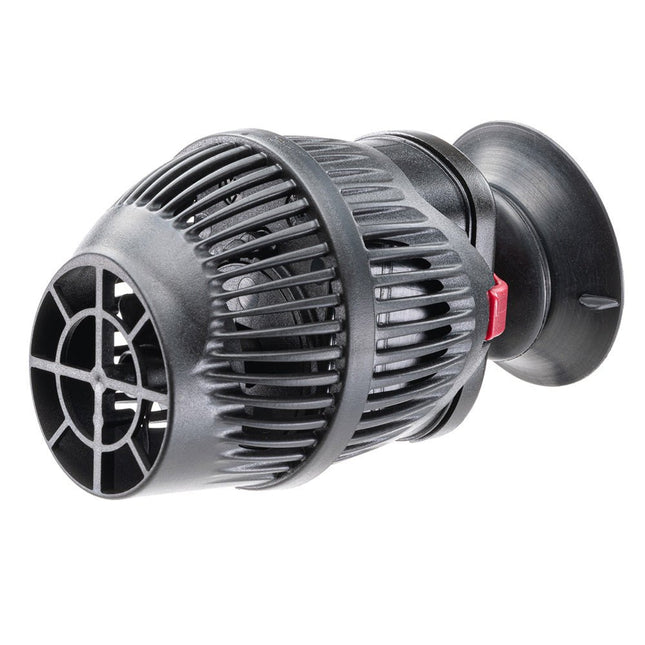
Description Compact and energy saving, this Koralia pump is ideal to recreate in your aquarium the natural and beneficial water motion of rivers and seas. It includes a magnet-suction cup support for easy and safe positioning. Koralia can be connected to a controller and set to intervals of seconds, minutes or hours. Cable protector included. Characteristics Movement pump ideal for marine aquariums, specially designed for small reefs It can also be used in fresh water tanks Pumps allow a wide flow to increase water movement which is essential for Corals and Plants. Compact format with high performance and low energy consumption Easily adjustable flow direction thanks to the sphere joint Magnet suction cup support included: easy positioning, for aquariums up to 10 mm thickness It can be connected to a timer with programmed intervals (seconds, minutes, hours) Equipped with cable protector, ideal use is tanks with urchins, triggers, puffers or parrot fish Koralia Nano is designed for use in aquariums only, it cannot be used as a filter pump This pump is intended for indoor use only in water with a temperature up to 35° C (95° F) Available in different models: 900 of 4,5 W, maximum pump flow rate 900 l/h, recommended for fresh water tanks from 60 to 100 litres, marine water from 36 to 60 litres 1600 of 4,5 W, maximum pump flow rate 1600 l/h, recommended for fresh water tanks from 100 to 180 litres, marine water from 64 to 100 litres 2200 of 4 W, maximum pump flow rate 2200 l/h, recommended for fresh water tanks from 140 to 250 litres, marine water from 90 to 140 litres USER MANUAL
$79.95

“Araguaia” is a river system in Brazil and it is under this name that the plant has become known. There are many signs, however, that the plant is a Hygrophila lancea from Japan and Hong Kong. The stem becomes 10-20 cm tall and 6-15 cm wide. It has compact, tight-sitting leaves and grows branches easily. Pinching of the stems maintains a bushy look. The colour is reddish brown to purple, promoted by good growth conditions. The growth rate is average for a Hygrophila. Plant info Type: Stem Origin: Asia Growth rate: Medium Height: 10 - 20+ Light demand: Medium CO2 : Medium
$10.00
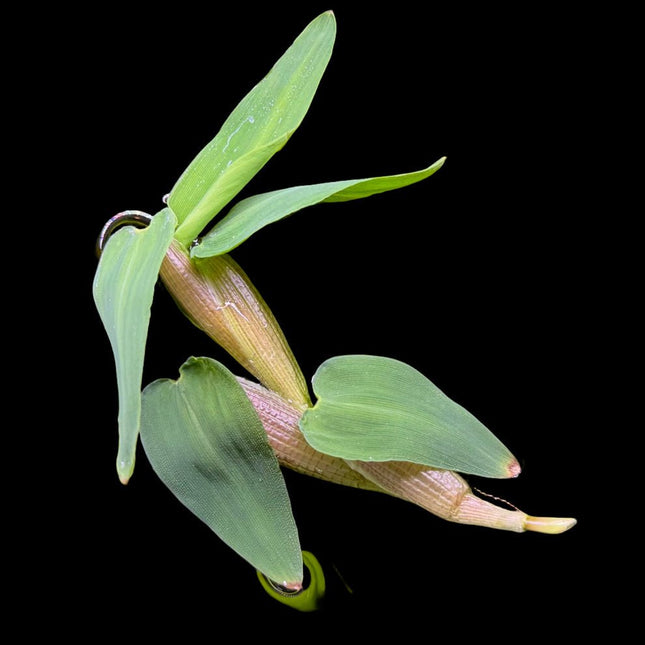
Hygroryza aristata is a unique floating aquatic plant in the Poaceae family. This species is known for its attractive appearance and ability to create a lush, green canopy on the water's surface. Its floating nature and distinctive foliage make it a fascinating addition to any aquarium, providing both aesthetic appeal and functional benefits such as shading and habitat for aquatic life. Key Features: Scientific Name: Hygroryza aristata Common Name: None Family Name: Poaceae Water Parameters: Temperature: 22°C - 28°C pH: 6.0 - 7.5 Hardness: Soft to moderately hard water Light Requirement: Moderate to high lighting Bright light promotes vigorous growth CO2 Requirements: Not necessary Can thrive without CO2 supplementation Plant Appearance: Leaves: Narrow, elongated leaves that float on the water surface, forming dense mats. Growth Habit: Floating stems that spread across the water, providing cover and reducing algae growth by blocking light. Size: Can cover large areas of the water surface, suitable for tanks of various sizes. Care Tips: Regular trimming helps manage its spread and keeps the plant from overcrowding the tank. Thrives in nutrient-rich water, benefiting from regular fertilization. Ideal for providing shade and creating hiding spots for fish and invertebrates. Hygroryza aristata is an exceptional choice for aquarists seeking to add a unique, floating plant to their aquariums. Its ease of care and ecological benefits make it a valuable addition to any aquatic environment. Please note that depending on the season the look of this plant will vary
$9.95

Introducing InsectaSip, the innovative water replacement gel designed to revolutionize insect care. Say goodbye to messy water bowls and the risk of drowning with this solution. InsectaSip is a specially formulated gel made from all-natural ingredients, providing essential hydration to live insects without the hassle or dangers associated with traditional water sources. Simply place a small amount of InsectaSip in your insect enclosure, and watch as your insects thrive in a safe and controlled environment. With InsectaSip, there's no need to worry about spills, leaks, or the constant upkeep of water bowls. The gel consistency ensures that your insects have access to hydration without the risk of drowning, keeping them healthier and happier for longer. Whether you're caring for crickets, roaches, or other live insects, InsectaSip is the convenient and reliable solution you've been searching for. Make the switch today and experience the difference with InsectaSip – the future of insect hydration.
$14.00
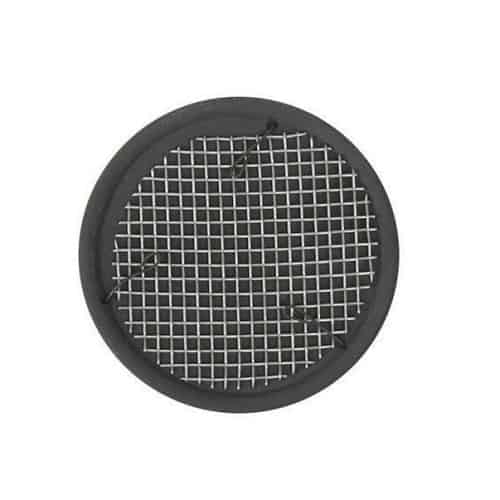
The ISTA Plant Cultivation Plate Round is a circular, multi-level, hydroponic growing system designed for easy and efficient cultivation of leafy greens and herbs. The plate features four levels with built-in trays and dividers that can be filled with water, soil, or compost. Each level has its own built-in drainage system to ensure proper hydration and aeration of the plants. The plate also includes a LED grow light and plug to provide the plants with the necessary light, and an adjustable stand to adjust the light to the plants’ needs. The ISTA Plant Cultivation Plate Round is perfect for indoor gardening, and can easily be placed on any countertop or windowsill.
$15.00

Jacaranda seed pods are sold in groups of 4 halves ( 2 pods). Botanicals not only enhance the visuals of your aquarium but also bring a bunch of extra benefits such as: Releasing tannins. Help lower pH. Aid in disease prevention, both bacterial and fungal. Provide an excellent environment for biofilm and microorganisms to grow, which provides microscopic foods for fry, shrimp, apistogrammas other small fish. Enhance a natural behaviour in your fish. All our botanicals are prepared carefully, being boiled and dried out with any seeds being removed as best as we can.
$4.95
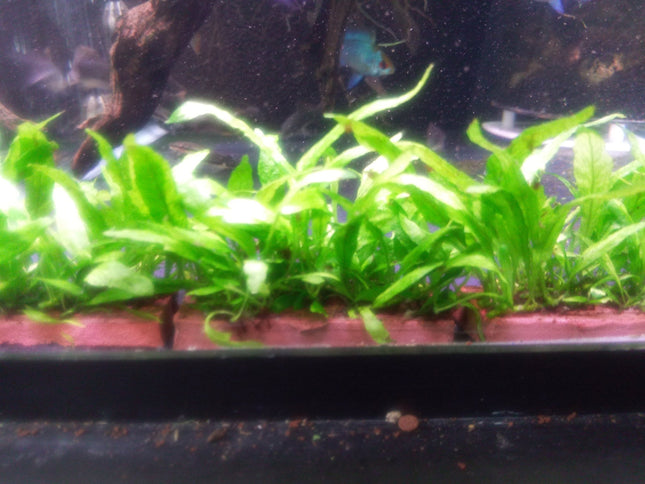
Java-fern-mini is a small, low-maintenance aquatic plant with delicate, bright green leaves. It is a popular choice for aquascaping and aquarists alike due to its low-maintenance nature and its ability to thrive in low-light conditions. It is easy to propagate and can be grown both submerged and emerged, making it a versatile plant for aquariums of all sizes. Its leaves provide a natural filter for the water, removing toxins and pollutants, and its roots help to keep the aquarium substrate clean. This came in a small terracotta pot. It will stay smallish.
$15.00

The JBL 12/16mm Aquarium Hose on a 50m reel provides a durable and flexible solution for aquarium connections, ensuring efficient water flow and easy setup. Its high-quality, grey material is safe for aquatic life and offers ample length for various aquarium applicationS
$8.00

The JBL 16/22mm Aquarium Hose on a 25m reel provides high-flow, durable tubing for powerful aquarium systems, ensuring efficient water circulation. Its robust yet flexible design and aquatic-safe material make it ideal for demanding filtration setups. Supplied in 1 meter amounts. Please let me know by the quantity how much you require
$8.00

JBL Fish Transport Bag Large 24×52 cm Each Pack carries 100 Bags with Holes in the top to hang and easliy rip each individual Bag out to use. Double taped seams Rounded heat-sealed corners at the bottom
$69.00
You have seen 288 out of 936 products